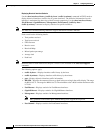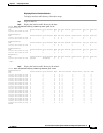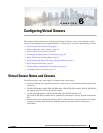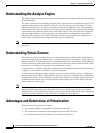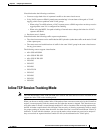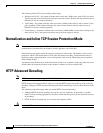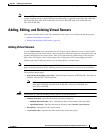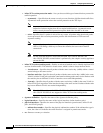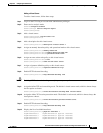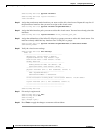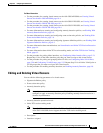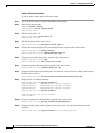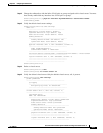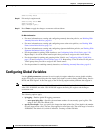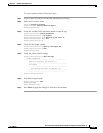
6-6
Cisco Intrusion Prevention System CLI Sensor Configuration Guide for IPS 7.1
OL-19892-01
Chapter 6 Configuring Virtual Sensors
Adding, Editing, and Deleting Virtual Sensors
• inline-TCP-evasion-protection-mode—Lets you choose which type of normalization you need for
traffic inspection:
–
asymmetric —Specifies that the sensor can only see one direction of bidirectional traffic flow.
Asymmetric mode protection relaxes the evasion protection at the TCP layer.
Note Asymmetric mode lets the sensor synchronize state with the flow and maintain
inspection for those engines that do not require both directions. Asymmetric mode
lowers security because full protection requires both sides of traffic to be seen.
–
strict—Specifies that if a packet is missed for any reason, all packets after the missed packet
are not processed. Strict evasion protection provides full enforcement of TCP state and
sequence tracking.
Note Any out-of-order packets or missed packets can produce Normalizer engine signatures
1300 or 1330 firings, which try to correct the situation, but can result in denied
connections.
Note For the ASA IPS modules (ASA 5500 AIP SSM, ASA 5500-X IPS SSP, and
ASA 5585-X IPS SSP), normalization is performed by the adaptive security appliance
and not the IPS.
• inline-TCP-session-tracking-mode—Enables an advanced method used to identify duplicate TCP
sessions in inline traffic. The default is virtual sensor, which is almost always the best choice.
–
virtual-sensor —Specifies that all packets with the same session key (AaBb) within a virtual
sensor belong to the same session.
–
interface-and-vlan—Specifies that all packets with the same session key (AaBb) in the same
VLAN (or inline VLAN pair) and on the same interface belong to the same session. Packets with
the same key but on different VLANs or interfaces are tracked independently.
–
vlan-only—Specifies that all packets with the same session key (AaBb) in the same VLAN (or
inline VLAN pair) regardless of the interface belong to the same session. Packets with the same
key but on different VLANs are tracked independently.
Note The ASA IPS modules, (ASA 5500 AIP SSM, ASA 5500-X IPS SSP, and
ASA 5585-X IPS SSP) do not support the inline TCP session tracking mode.
• signature-definition—Specifies the name of the signature definition policy.
• logical-interfaces—Specifies the name of the logical interfaces (inline interface pairs).
• physical-interfaces—Specifies the name of the physical interfaces (promiscuous, inline VLAN
pairs, and VLAN groups):
–
subinterface-number—Specifies the physical subinterface number. If the subinterface-type is
none, the value of 0 indicates the entire interface is assigned in promiscuous mode.
• no—Removes an entry or selection.



